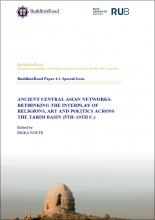We log anonymous usage statistics. Please read the privacy information for details.
BuddhistRoad Paper 6.1. Special Issue: Ancient Central Asian Networks, ed. Erika Forte. “Tibetan Dominion over Dunhuang and the Formation of a Tibeto–Chinese Community”
Synopsis
The Tibetan dominion over Dunhuang (786–848) had an inevitable influence on the social life of the Chinese inhabitants. The manuscripts, both Chinese texts written in Tibetan script and Tibetan texts recognized as being for use by Chinese people, indicate the existence of a 'Tibeto-Chinese community' in Dunhuang. This assertion can be supported by Chinese poems, transcribed in Tibetan script, as well as by association (Chin. she 社) documents and texts on the Chinese Five Surnames theory written in Tibetan. This article puts its focus on when and how this Tibeto-Chinese community was formed, and how long it had lasted. The Tibeto-Chinese community remained in existence even as far as the Guiyijun period (from 848 until the beginning of the 11th c., 歸義軍), which can be observed through two-time varying systems of Tibetan transcription of Chinese characters—one is the dialect of Chang‘an (長安) and the other is the local dialect of Dunhuang (敦煌), a variety of the North-Western dialect of Chinese. As a supplementary material to reinforce this argument, the author also presents the Chinese text Yuan xinlang (願新郎 [Prayer for the Groom]—a text to be recited for wedding ceremonies) written in Tibetan script which can be dated to the Guiyijun period.
Chinese Translation
吐蕃对敦煌的统治 (786-848) 对汉人居民的社会生活产生了不可避免的影响. 用藏文字母转写的汉文文本和被认为是供汉人使用的藏文文本, 表明在敦煌存在着一个 “藏汉社区”. 用藏文转写的汉语诗歌以及用藏文书写的社邑文书和关于五姓说的文本都可以支持这一论断. 本文重点讨论了这个藏汉社区是何时, 如何形成的, 以及其存续时间. 藏汉社区甚至在归义军时期 (从848年到公元11世纪初) 仍然存在, 这可以通过两种不同的藏文转写汉字系统判断得知, 一种是长安方言, 另一种是属于汉语西北方言的敦煌地方方言. 作为加强这一论点的补充材料, 笔者还介绍了用藏文字母转写的汉文文本《愿新郎》—一种在婚礼上诵读的文本, 其年代可追溯到归义军时期.

Downloads
Published
Categories
License

This work is licensed under a Creative Commons Attribution-NonCommercial-ShareAlike 4.0 International License.

